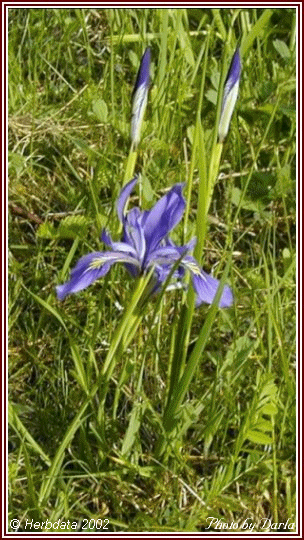

" Blue
Flag is the dried rhizome of Iris versi-color
Linne, or of Iris caroliniana Watson (Fam. Iridacece).
Blue Flag contains not more than 5 per cent, of its roots and leaf bases
or other foreign organic matter." N. F.
Blue
Flag, Larger Blue Flag; Amerikanische Schwertel,;
Iris Varie, Fr.
Iris versicolor
L., or blue flag, is found in all parts of the United States, flourishing
in low wet places in meadows.
Description
and Physical Properties. � " Unground Blue Flag.�Rhizome
frequently branched, up to 20 cm. in length and 3 cm. in thickness at the
nodes, usually cut into longitudinal pieces; outer surface grayish brown
to purplish brown, somewhat annulate, the upper surface with markings of
leaf bases, the lower with numerous root scars and root remnants; fracture
short, the broken surface yellowish white, pink or pale to dark purplish
brown and exhibiting a central stele with whitish fibro-vascular bundles
distributed throughout, a distinct endodermis, and cortex. Odor slight,
not distinctive; taste acrid, nauseous.
"Structure.�
A more or less exfoliating epidermal layer of cells with brownish walls; a
hypodermis of about two rows of cells with uniformly thickened, strongly lignifled
walls, some of which contain a reddish-brown amorphous
substance; a narrow cortex of characteristic structure with ovoid or
spheroidal parenchyma cells with large intercellular spaces, some of the
parenchyma containing starch, others a reddish-brown amorphous substance;
an endodermis of a single layer of cells with walls lignifled
and thickened on the inner and radial surfaces; a central cylinder made up
of numerous nearly spherical parenchyma, between which are intercellular
spaces not as large as those in the cortex; concentric vascular bundles
occasional in the cortex, more numerous in the parenchyma of the central
cylinder.
"Powdered
Blue Flag.� Reddish-brown; numerous resin cells filled with a
reddish-brown amorphous substance; starch grains few, or in some specimens
abundant, simple or 2- to 4-com-pound, the simple grains being spherical
or elliptical, up to 0.022 mm. in diameter; calcium oxalate in prisms up
to 0.350 mm. in length; tracheae with spiral or reticulate markings or
bordered pores; fibers few, lignified and with oblique pores." N. F.
The active
principle of blue flag is unknown. The name iridin
is applied to the oleoresin obtained by precipitating the tincture of the
root with water. Irisin is a somewhat similar
preparation in which the oleoresin is stiffened by the addition of the
powdered root. For chemical examination of the resin see Power and Salway
(A. J. P., 1911, Ixxxiii, p. 14).
Uses.�
Blue flag root is a cathartic and emetic said to have been used by the
Indians of the Southern United States. By some it is supposed to have a
special effect upon the liver and is used as a cathartic in biliousness.
The eclectic physicians attribute to it also alterative powers and employ
it in various skin diseases, chronic rheumatism and similar complaints.
Dose,
ten to thirty grains (0.6-2 Gm.).
Off. Prep.� Fluidextractum Iridis Versicoloris, N. F.; Elixir Corydalis Compositum, N. F.; Fluidextractum Stillingis Compositum, N. F.; Syrupus Stillingias Compositus, N. F.
![]()